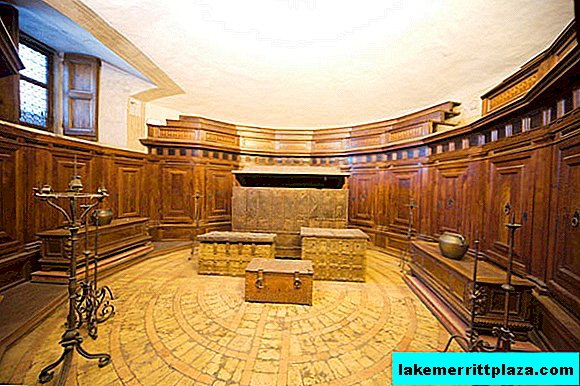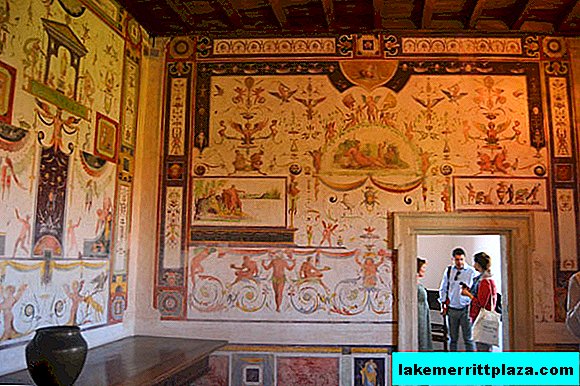Castle of the Holy Angel in Rome (Castel Sant'Angelo) has a grandiose appearance and no less impressive history. Cylindrical a mausoleum built at the dawn of Christianity on the banks of the Tiber, during his long life managed to visit the last refuge for the Roman emperor, the residence of the pontiffs, turn into a fort, then into a dungeon, and subsequently receive the status of a museum and a treasury.
Story
Mausoleum of Adrina

The tomb of the emperor Hadrian Publius (lat. Publius Hadrianus) was erected on the high bank of the river around 139 AD. In the original, the mausoleum had a cylindrical shape and was richly decorated. The flat roof of the building was decorated with a decorative garden, in the center of which a gilded quadriga was installed. In 138, the ashes of Emperor Hadrian were placed in a tomb, together with the urns of his wife Sabina and adopted son. Also, on the orders of Hadrian, the Bridge of the Holy Angel (Ponte Sant'Angelo) was built, leading from the center of Rome to the tomb.
Decline
By the 5th century A.D. Adrian's mausoleum lost its former splendor and solemnity, as it was gradually turned into a military fortification. During the invasion of the Goths, most of the bronze ornaments, urns and statues were stolen or destroyed.
There is a legend that says that Archangel Michael appeared over the mausoleum, sheathing his sword. So it was marked the end of the plague in 590 AD In honor of this sign, the tomb received its current name.
Another curious fact: in Italy, and in many other European countries, a person who has just sneezed is said, “Blessed be!”, an analogue of our “Be healthy!”. So, in the Middle Ages it was believed that the plague begins with attacks of sneezing. And only God could help a sick person with a plague!
Fortress, papal residence and prison

By the 14th century, the Castle of the Holy Angel in Rome turned into the residence of the popes. Nicholas III (lat. Nicolaus III), connected the castle with the Basilica of St. Peter (Basilica Papale di San Pietro in Vaticano) using a covered corridor called Passetto (Passetto di Borgo). During the invasion of the army of Charles V (Carolus V) in 1527 in Rome, Pope Clement VII (Latin Clemens VII) found refuge in the walls of the castle. The inhabitants of the besieged fort actively attacked the attackers, through the windows-loopholes. Among the glorious defenders was seen sculptor jeweler Benvenuto Cellini (Benvenuto Cellini).

A little later, the pontificate arranged comfortable apartments in the mausoleum, in case the story of the siege of the capital repeats itself. Sadly, the Catholic Church also had to organize a dungeon within the walls of the fortified castle.
So famous the medieval scientist, astrologer and Dominican monk Giordano Bruno was imprisoned in the walls of Castello San Angelo for 6 years!
It is noteworthy that the defender of Fort Benvenuto Cellini, after some time fell into disfavor of the pontificate and also ended up in jail. A deft and skillful sculptor, Cellini, managed to escape from the castle.
Since 1901, Castel Sant'Angelo was officially declared a national museum (Museo Nazionale di Castel Sant'Angelo).
Architecture
Even under the emperor Hadrian, the main architectural ensemble of the Castle of the Holy Angel took shape. The powerful cubic base was lined with expensive marble. On top of the pedestal stood the “puck” of the mausoleum, made of volcanic stone. Outside, the building was lined with travertine and decorated with carved pilasters in the form of cattle heads (Bucrani). The tomb was surrounded by a wall that had a decorative and fortification purpose.
Nowadays, the castle looks much more modest than it was under Hadrian. Travertine, marble, pilasters and bronze have been confused for centuries. However, the external structure of the mausoleum remained virtually unchanged. A much stronger structure was transformed from the inside. The ancient tombs in which the emperor and his family rested, as well as Anthony Pius, Mark Anthony and those close to them, were severely destroyed. Ballot boxes with ashes are lost.

Already in the 14th century, the mausoleum was turned into a fortress. Pope Boniface IX (lat. Bonifacio IX) instructed the architect Niccolò Lamberti to strengthen the castle walls, equip the bastions and create a single entrance in the form of a drawbridge. A new building has appeared in the building itself - the chapel of St. Michael (Cappella San Michele Arcangelo).
In the 15th century, Pope Alexander VI (Alessandro VI) of the Borgia family set the task for the architect Antonio da Sangalo Sr. (Antonio Giamberti da Sangallo) to turn the castle into a full-fledged stronghold. Four bastions strengthened the building, and a moat was dug around the buildings. The fortress was equipped with papal apartments in which Pinturicchio himself painted frescoes. The new palace of Alexander VI served for luxurious receptions and celebrations.

In 1536, Raffaello da Montelupo created a statue of Archangel Michael with a sword. The marble saint with bronze wings reminds the Romans of the events described in the legend and guards the castle. In the 17th century, the Angel Courtyard appears on the territory of the Castle, in which the archangel in the performance of de Montelupo found his place.
In the second half of the 17th century, Urban VIII (Lat Urbano VIII) destroyed most of the military and decorative buildings of the 15-16th century to create a new version of the fort with a powerful defensive wall and fortifications. In 1667, the bridge of Sant'Angelo (Ponte Sant'Angelo), leading to the castle, began to be decorated with statues of angels. For 2 years, Giovanni Lorenzo Bernini and his students performed 10 baroque sculptures that protect the bridge to this day.

In the 18th century, the stone archangel Michael was continued in bronze. The work of the Flemish sculptor Peter Anton von Verschaffelt (Peter Anton von Verschaffelt) still adorns the roof of the castle.
What to see

For modern visitors, the Castle of the Holy Angel will appear in the form of attractions divided into 6 levels:
- Courtyard of the Savior, work rooms Boniface XI, patioin which the execution of convicts was previously carried out, Chapel of the Holy Crucifixserving for the last prayer of the doomed prisoners, roman atrium - An ancient arch leading to the tomb of Hadrian and a spiral descent to the tomb.
- Corridor and Hall, in which the ashes of the emperor and his family were kept, prison facilities, pantries for grain and products created in the 16th century, oil storage facilities - universal remedy in case of siege.

- Courtyard of the Angel Clement III Hall (lat. Clemens III) - a beautiful fireplace and a door decorated with carvings, courtroom decorated with medieval cannons and cores, on the wall - part of the mural depicting an angel Apollo Hall - a place for social receptions, serving the pontiffs, Chapel of Saints Cosmas and Damian (Capella dei SS. Cosma e Damiano), Clement VII Hall, the courtyard of Alexander VI, equipped with a well, courtyard and chapel of Leo X (lat. Leone X), beautifully designed Clement VII swimming pool works by Giovanni da Udine.
- Indoor galleryin which, in the Middle Ages, pilgrims marched to meet with the Pope, rooms of Pius IV (lat. Pio IV), Loggia Julia II (Giulio II), overlooking the city and Elio Bridge, is attributed to the works of Giuliano da Sangallo, vast arsenal, which contains a collection of weapons and military uniforms of the 15-20 centuries, Loggia of Paul III, is on the opposite side relative to the loggia Julia (looks at Via Flaminia), Paolina Hall - part of the most richly decorated apartments of Paul III Farnese (lat. Paulus III), Perseus Hall thematically decorated based on the legend of the same name, the hall of Amur and Psyche continues the theme of mythology.

- Treasure chest - a round room, containing in itself in the 15-16 centuries the wealth of the pontificate, librarybegun by Paul III Adrianeo and Garland Halls richly decorated with frescoes of the 16th century, triple rooms bearing the name Kaliostara (Cagliostra) once served as an apartment for Count Cagliostro himself, between the library and the Apollo hall there is the Pompeano corridor, decorated with intricate ceiling paintings, the room of the custodian of the castle of the 18th century.
- Round Hall, Column Hall, built and decorated with marble columns by order of Benedict XIV, now serves as a repository for the banners of the Italian infantry. Through the round hall you can get to Terraced Angel (Terrazzo dell'Angelo), which offers an unforgettable view of the whole of Rome.

How to get there
- Address: Lungotevere Castello, 50
- Metro: line A (stations: Lepanto, Ottaviano-San Pietro).
- By bus: No. 62,40,23,271,982,280 (stop: Piazza Pia), No. 34 (stop: via di Porta Castello), No. 49,87,926,990 (stop: intersection of Piazza Cavour and via Crescenzio), No. 46,64 (stop: Santo Spirito) .
- Opening hours: from 9:00 to 19:30; The ticket office closes at 18:30.
- Ticket price: 10 euros, preferential for citizens of the European Union from 18 to 25 years old - 5 euros. For groups starting from 20 people, a reservation of 1 euro per visitor is provided.
- First Sunday of every month admission to the museum in the Castle of St. Angel is free.
- Phone: +39 06 32810
- Official site: www.castelsantangelo.com











